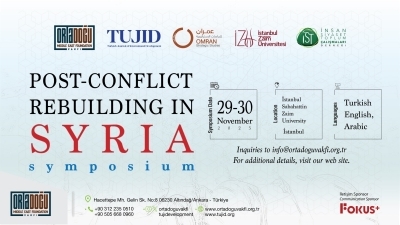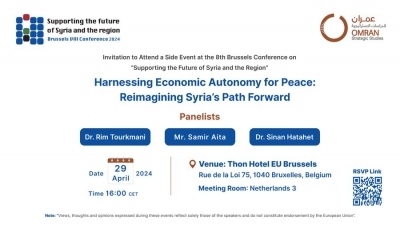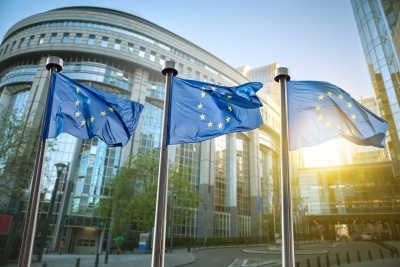Executive Summary
- The announcement of the establishment of the National Union of Syrian Students took place in April 1963. However, the Union remained without an official status and was not legally recognized until 1966 when Decree No. 130 was issued. The decision to establish the Union was made by the Regional Leadership of the Ba'ath Party, designating it as the sole "legitimate representative" of the student sector both within and outside Syria. Yet, Decree 23 of 1970 limited the Union's activities to university students, while the "Union of Revolutionary Youth" catered to students below the university level. Since then, the connection of the Union (legally, functionally, and structurally) with the central leadership of the Ba'ath Party became quite evident. Despite this, the party law issued in 2011 allowed the establishment of political parties and party activities in Syria. This was later followed by a constitutional amendment in 2012 that abolished the provision stating that the Ba'ath Party is the leader of the state and society, However, the union has remained inextricably linked to the Baath Party.
- Three laws were issued to regulate universities in Syria. The first was in 1958, which completely ignored any student representation within the university educational process. The second was in 1975, which introduced the concept of the National Union of Syrian Students as one of the entities overseeing the university educational process. The latest was the 2006 law, which limited student representation to those appointed by the Union in faculty councils and university scientific affairs councils. This law underwent several amendments adding new categories to scholarship recipients, accommodating individuals who joined the army after 2011.
- Student organizations at all levels, starting from the "Ba'ath Vanguards", passing through the "Union of Revolutionary Youth", and ending with the National Union of Syrian Students, serve as training centers for Ba'athist cadres. Upon graduation, these cadres either move on to lead unions or assume other positions in the state. Through these sequential institutions, students are conditioned on one hand, and their loyalty to the ruling authority is ascertained on the other. Consequently, the idea of elections within the Union is more about affirming the loyalty chain rather than being a democratic process where students choose their representatives, who are then tasked with advocating for student rights in educational and ministerial councils.
- The universities vary in the composition of their union branches, which can be divided into three types: branches where the sectarian dimension is evident within the union's structure, such as the Tishreen and Baath branches; branches where the composition is related to cities and the distribution of power, such as Aleppo and Damascus; and branches where the union leadership does not have significant influence within the overall union, and the members are often from the same city, such as the Deir ez-Zor and Daraa branches. This diversity has impacted the roles of the union and its interactions in the post-2011 era.
- Among the roles and tasks of the union, one notes its functional role, as manifested through its interaction with the regime's foreign policies and its support for internal decisions at both the university and state levels. There is also its military role, evident through its activities with the Baath Brigades in 2012, arming supportive students and overseeing their inspection of other students. In addition, there is its political role, either in promoting the regime's narrative or in developing strategies to counteract sanctions imposed upon it. Despite these sanctions, the union has remained an active participant in international conferences, representing the Assad regime. Finally, the union has a social role, which involves supporting the regime socially beyond the university setting, as exemplified by the establishment of institutions focused on relief efforts, such as the "Wounded Homeland" project.
Introduction
Understanding the social and political structures that the Assad regime controls is a fundamental step towards understanding the dynamics of its governance and its executive vision for political and social life. The levels of analysis range from an internal examination of social structures to analyzing their relationship with the ruling regime, and to what extent each influences the other in decision-making processes or changing societal ideas, all the way to altering its composition and beliefs. From this perspective, we study the dynamics and philosophy of the “National Union of Syrian Students” as the sole organizational framework for students on one hand, and as a host for the potential carriers of developmental and progressive ideas on the other hand, while attempting to understand how it monopolizes student work and uses it to serve the regime's narrative.
Research issues related to the Union have occupied varying spaces in the field of studies. Some have tried to quickly touch on some of these issues such as the relationship between the Union and the Ba'ath Party, as done by Adnan Amin in his research on governance of education in the Arab world. He pointed out the Ba'ath's control over the entire educational process, whether at the level of the Teachers' Union, which was transformed from an independent entity into a popular organization, including all civil service employees in the ministries of education, or at the level of forcibly affiliating students to the Union, while prohibiting any political activity in universities outside the Union framework. Amin, however, did not touch on the legal frameworks, legislations, and decrees that led to Ba'ath's control over trade union work, especially student work.([1])
Meanwhile, other studies focused directly on presenting a model of co-opting student work through its militarization by forming “Ba'ath Brigades” from students in Syrian universities to be ancillary forces for the regime's army, or even to monitor and chase activists outside the university framework, or through unofficially arming supporting students to control universities and their affiliated dormitories to prevent any revolutionary activity within them. This was clarified by Ali Jasim in his research paper “Under the State: The Rise of Ba'ath Brigades at Aleppo University after 2011” ([2]), and it was also demonstrated by testimonies of some students in favor of a research paper issued by the International Foundation for Education at the University of California, titled “Syrian University Students and Professors in Turkey”. These testimonies focused on cases of arming students and their role in arresting and torturing their peers.
Moreover, Rahaf Dagali's study in her paper issued by the British Journal of Middle Eastern Studies, titled “Departure of Secularism: Seizing the Borders and Expanding the Syrian State in the Religious Field Since 2011”, shed light on an important aspect in the dynamics of linking civil institutions in Ba'ath policies. It looked at the model of the twinning of one of the organizations affiliated with the Ba'ath and the Ministry of Religious Endowments, through the launch of the Religious Youth Team associated with the Ministry of Religious Endowments and its cadres from the National Union of Syrian Students, to establish religious awareness projects and dialogue sessions.([3])
In light of that, this study identifies its qualitative scope by focusing entirely on understanding the complete picture of the Union and its roles and activities, and clarifying the impact of the legal engineering that regulates its work on enhancing the regime's tools in absolute control of civil institutions on one hand and mobilizing emerging generations and using them as a soft tool to serve the regime's policies and maintain its narratives on the other. The study will rely on the historical method to understand the Union's historical dynamics, and to show the reciprocal relationship between these dynamics and the regulating laws. It will also rely on the analytical method and its tools in monitoring its activities and purposes that transcend organizational rules, especially after 2011, let alone drawing the structural frameworks that regulate the work of this civil organization.
Therefore, drawing the legal frameworks and organizational structure would be a unique entry point in understanding the dynamics of the regime in monopolizing the civil space and exploiting it in “protecting” its general narrative, whether through reading the regime's ability to adapt these frameworks with the developments of the public scene, or through tracking the change in the Union's roles within the needs of the regime and its challenges. That will also somewhat contribute to shaping valid recommendations for this exploitation and investing it for the benefit of creating independent student spaces.
Historical Brief: Regulation and Control of Union and Civil Work
In the early 20th century, union work in Syria emerged as an upgrade of the professional and craft associations compared to the 19th century. This was driven by the necessity to protect occupations from unjust practices and prejudiced laws issued by authorities, and the need for internal leadership, such as the concept of “Sheikh al-Kaar”([4]) to regulate work and arbitrate disputes among members of the same profession. Union work began to shine through the Ottoman state's decision in 1909, which its influence continued during the French “mandate” era later until 1935, due to the absence of legislation related to civil work in this era, ([5]) which was naturally reflected in the establishment of several unions during this period, such as the Bar Association, ([6]) and the labor movement.([7])
In the post-independence era, despite the continued absence of updated legal frameworks, union and student gatherings developed tools for local confrontation. While they adopted the narrative of demanding independence and rejecting division during the mandate era, they began demanding the preservation of rights and resisting attempts to suppress freedoms by the military and some political powers during the independence era. This was evident in the first direct clash between the student movement and the military led by Sami Hanawi. This dynamic was a contributing factor in the adoption of the 1950 constitution, which expanded the scope of civil and union work in Syria. This is reflected in Article 17, which gave citizens the right to form associations and practice union work.([8])
During the unity phase between Syria and Egypt, the authorities attempted to control the funding sources of organizations and unions, frame their work, and reduce their freedom spaces to “regulate the rhetoric directed against the state in both countries.” As a result, Law No. 93 of 1958 was issued, ([9]) which is considered the first law to legitimize the state's full authority over civil work and its funding sources. This law remained a basis for laws related to organizing the scope of civil work and linking it to the state until the present time. The law added three new tools for government dominance over civil work:
● Deprived people who had political trials of their social rights
● Gave the authority the right to appoint one or more members in the administration of the association or organization
● Allowed the relevant ministry to suspend the work of the organization or association if it saw no need for its existence.
These loopholes allow the state to undermine civil work initially so that it does not become an obstacle to its decisions and paves the way for civil work to become a tool to frame, control, and market the ruling party's narrative within society.
Legal Frameworks Regulating Student Work During the Ba'ath Era: Control and Exploitation
Following the Baath takeover in 1963, the party's military committee sought to curtail civil activism in society. This marked the beginning of subsequent legislation. The progression of these laws began by suppressing civil activism, then shaping and directing it to benefit the ruling authority, and eventually identifying funding avenues for it. Moreover, these laws were adapted in response to domestic shifts, particularly post-2011.
The Ba'ath as an Administrative and Organizational Controller of the Student Union
Following the Ba'ath takeover in 1963, there was a comprehensive clampdown on all forms of civil, social, and labor activism. As per Article 9 of Legislative Decree No. 68, the National Council for the Leadership of the Revolution was granted oversight of all civil organizations in the nation. This move was instrumental in channeling civil society to align with the interests of the governing power. A month after the Ba'ath coup, the "National Union of Syrian Students" was proclaimed. However, this was primarily a public announcement, with no concrete legislation outlining its functions, operational areas, or organizational guidelines.
This was done to regulate and control student activism, fearing a repeat of the student movements that opposed the authority in the 1930s and 1940s, which led at the time to changes in decisions due to popular and student pressure. The union remained unofficial and unregulated until 1966 when President Nureddin al-Atassi issued Legislative Decree No. 130, establishing the National Union of Syrian Students, which included students from all levels: primary, preparatory, secondary, and university students. ([10])
This decree marked the first direct integration of a segment of civil activism in Syria under the banner of the Ba'ath Party. It was followed by other segments such as the Teachers' Union, as part of the Assad regime's strategy to monopolize absolute power and transform civil activism into a tool under its control. The decision to establish the Union was made by the party's central leadership, declaring it the sole legitimate representative of the student sector inside and outside Syria. However, the Union's scope of work was later limited to university students after the issuance of Legislative Decree No. 23 in 1970, establishing the Revolutionary Youth Union to oversee students below the university level.([11])
In the early 1970s, the Ba'ath Party solidified its absolute control over the state and society through Article 8 of the 1973 Constitution, which declared that “the Arab Socialist Ba'ath Party is the leading party in society and the state and leads a progressive national front working to unify the energies of the people and put them in the service of the goals of the Arab nation.” Later, in the 10th Congress of the Union in 1990, it was claimed that Hafez al-Assad's meeting with students in 1950 was the founding congress of the Union([12]), despite the absence of any mention of this conference or meeting in historical references or personal memoirs of politicians who were contemporaries of that period, such as Akram al-Hawrani and Sami al-Jundi, who extensively documented student activism in their personal memoirs. However, this narrative was presented by the Assad regime as part of the overall image that portrays Hafez al-Assad as the “founder of modern Syria with all its social, political, and military details.”
Thus, the Ba'ath Party attributed the beginnings of student activism to Hafez al-Assad's conference, neglecting the student movements in the pre-independence period and pre-coup period.
Later, in two separate periods, the Assad regime issued two laws to regulate universities: Law No. 1/1975 and Law No. 6/2006. These laws were extensions of Law No. 184, which regulated universities during the unity period in 1958. Although Law 1958 was more detailed, it completely neglected any presence of students as entities within the university or student representation at the level of the Ministry of Higher Education's committees or executive regulations. In other words, Law 1958 neutralized any recognition of student associations demanding student rights or presenting their demands to the authorities. This was contrary to what the Assad regime did, as it initially harnessed student activism in all its forms within one body, and then subjugated this body to the constitutional and legal dominance of the Ba'ath Party.
The purpose of both laws was to regulate the relationship between the three entities responsible for the university educational process: the Ministry of Higher Education, the Teachers' Union, and the National Union of Syrian Students. Law No. 6/2006([13]) abolished the application of Law No. 1/1975([14]) and included procedural details related to universities and their affiliated institutes. The difference between the two laws lies in the role of the Union. Law 2006 restricted student representation to students appointed by the Union in the college councils and scientific affairs councils at the university. On the other hand, Law 1975 did not require that the students in those councils be members of the Union, although it is unlikely that students other than Union members would represent the students. However, the monopoly of student representation was regulated within the Law on the Organization of Universities in 2006, and subsequent appendices and amendments were added to Law No. 6. However, they did not alter the essence of the relationship between the three entities or curtail the powers of the Union. On the contrary, the Union gained seats in all councils and bodies associated with the ministry, including those related to the general budget,([15]) In addition, decisions were issued regarding the Union's sources of funding.
Union Funding: Fluid Dynamic
The internal regulations of the union state that its main sources of funding are primarily membership fees and the percentage deducted from registration fees in government and private universities and institutes, whether through regular ([16]) or parallel education. It also includes income from investment allowances and facility rentals owned by the union. Although the Law on the Organization of Universities did not specify the official sources of funding for the Union's work and activities, there was generally liquidity in section (b) of Article 196 of the executive regulations of the Law on the Organization of Universities in 2006. It stipulated the allocation of approximately 40% “of investment allowances in restaurants, forums, and cafeterias” that the Minister of Education has the right to allocate to beneficiary entities in coordination with the Minister of Finance. ([17])
Later, the Higher Education Council issued a decision in June 2011 stating that 20% of these allowances should be allocated for the Union's funding. Meanwhile, the Teachers' Union did not exceed 15%, and 5% went to the Health and Social Solidarity Fund at the university.([18])
However, the legal framework for these decisions existed 43 years ago when the Ba'ath regime issued Legislative Decree No. 16 in 1968, granting the Minister of Higher Education the authority to delegate the management of university cafeterias and clubs to the Union. Another official source of funding for the Union comes from the revenues of private universities. Nine years after the decree regulating private educational institutions for the post-university stage ([19]), the Assad regime issued Legislative Decree No. 87 in 2010, which regulates the relationship between private universities and the Union. It monopolizes the Union's control over any student or social activism within these universities and allocates 0.5% of the total revenues of private universities to the National Union of Syrian Students. Thus, the Union has two official sources of funding, in addition to unofficial sources from businessmen or security figures, either as rewards or allowances for organizing events and conferences that serve their interests.
Changes to University Regulation Laws after 2011
Even though the last law regulating universities was in 2006, amendments to some provisions of its executive regulations began after 2011, in line with the developments in the Syrian scene. Regarding Article 116 of the executive regulations, which pertains to scholarships and seats offered in higher educational institutions ([20]), it has witnessed various amendments to its original text, coinciding with three variables:
1. Widening of confrontations with cities outside the regime's control.
2. Increase in the number of casualties among its ranks.
3. Rise in the percentage of foreign fighters in its auxiliary forces, whether in battles or security operations.
Thus, it was modified as follows:
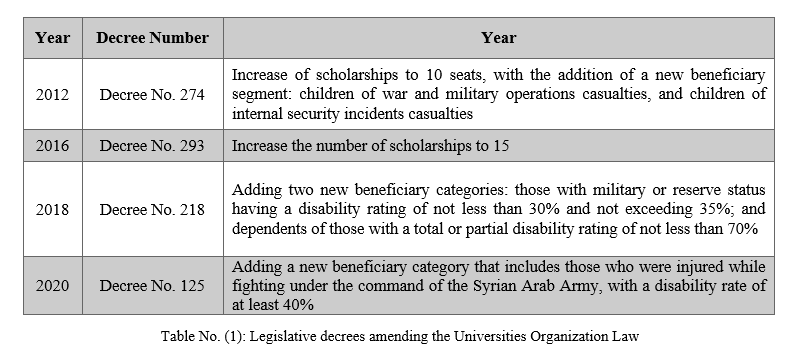
Thus, with the beginnings of the Syrian revolution, the Assad regime's government added new categories of beneficiaries to the scholarship recipients. These included the children of those killed in the Assad forces during the early years of the revolution. The provision of scholarships in universities was directly used as a tool to appease the factions affiliated with the army during the post-2011 years. The concept of university scholarships extended beyond those serving in mandatory military service or volunteering in the army to attract militias that do not belong to the army's structure and the armed forces, enticing them to participate in the regime's battles. This could potentially open the door to including injured individuals from non-Syrian militias in these university scholarships as well.
Structure: Regulation and Formation of Identities
Despite the establishment of the National Union of Syrian Students, its legal, functional, and structural affiliation with the central leadership of the Ba'ath Party has been evident. This is despite the issuance of the Parties Law in 2011, which allows for the establishment of parties and party activities in Syria. ([21]) The dominance of the Ba'ath Party over the state, including governmental institutions and civil society, including the Union and other unions and associations, continued even after the constitutional amendment in 2012 that abolished the provision stating that the Ba'ath Party is the leader of the state and society.
The central leadership of the Ba'ath Party issues the eligibility criteria for candidacy in the Central Council of the Union, as well as the decision to form its executive office (Appendix 1, noting that all current members of the executive office are Ba'ath Party members, except for one member from the Syrian Communist Party, who has the least interaction and appearance on the Union's platforms). Moreover, it is required that candidates for committees and student units be Ba'ath Party members and have their membership confirmed (Appendix 2).
The executive office was restructured in 2020, and the presidency of the Union was changed after stagnation in the position for more than 17 years, during which Ammar Saati remained at the head of the Union without any changes, except for periodic replacements of some names in the executive office. It is worth noting the repetition of names between the last two executive councils. Ammar Saati was promoted to become a member of the central leadership of the Ba'ath Party and the head of the Central Youth Office in the party, ([22]) while Daren Suleiman replaced him as the president of the Union. Daren Suleiman was previously a member of the executive office of the National Union of Syrian Students and the head of the Private Education and Informatics offices.
It is noteworthy that the age requirement is absent from the candidacy conditions for all levels of the Union's bodies, despite the existence of an article stating that senior members have the right to retain their membership for one term after graduation. However, previous members of the executive office continued to hold their positions for years without being enrolled in universities.
The structure of the National Union of Syrian Students is composed of a central council that includes representatives of the Union branches, and an executive office that is elected every five years (Figure 1).
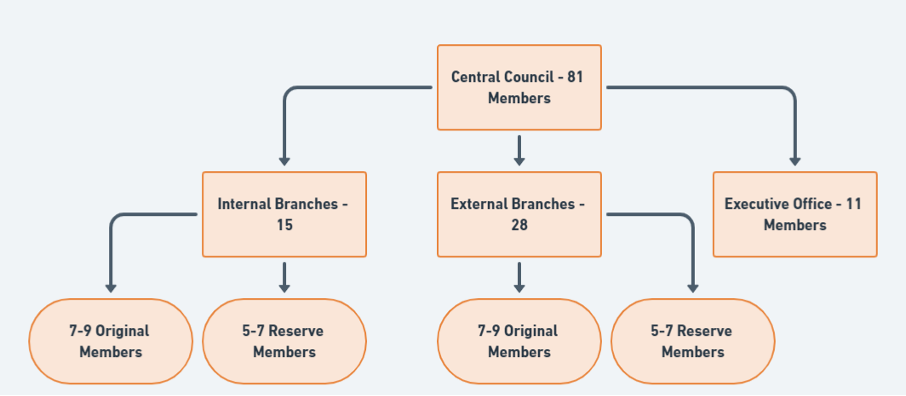
Figure (1): Structure of the National Union of Syrian Students
The internal branches of the Union branch out into student bodies for each college, which are elected every two years, and include student committees for each academic year, as well as a student committee for postgraduate studies. However, they do not have the right to vote in the body's meetings (Figure 2).
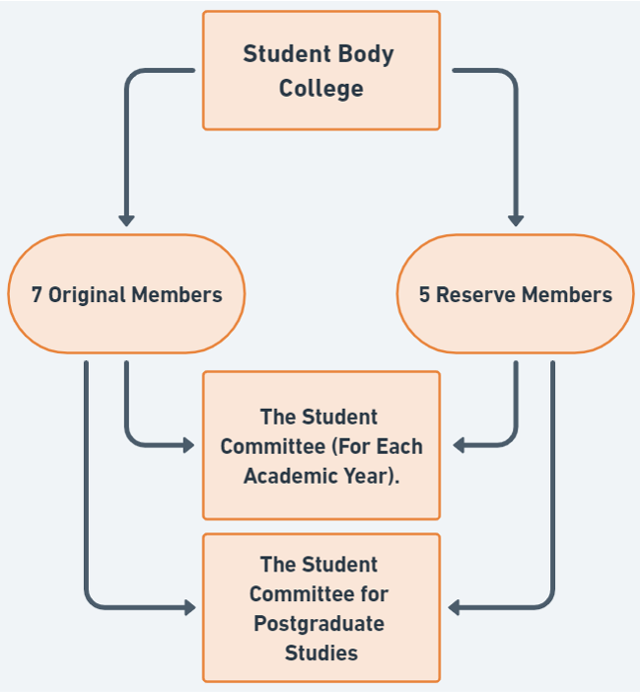
Figure (2): Structure of student bodies in colleges
Elections are held at the level of the Union's internal and external branches to select the representatives of these branches at the general conference, based on varying proportions of seats for each branch, as determined by the executive office. The general conference then generates the Union's central council, which in turn selects the executive office after the approval of the Central Committee in the Ba'ath Party on the chosen names (Figure 3).
Although numerous students participate in elections across colleges, branches, and the entire Union, over the last two terms, the executive office's composition has seen less than a 50% change. Many of those not currently in the executive office, like Bashar Mutlaq, Mohammed Ajil, and Omar al-Aroub, have been given different responsibilities. ([23])
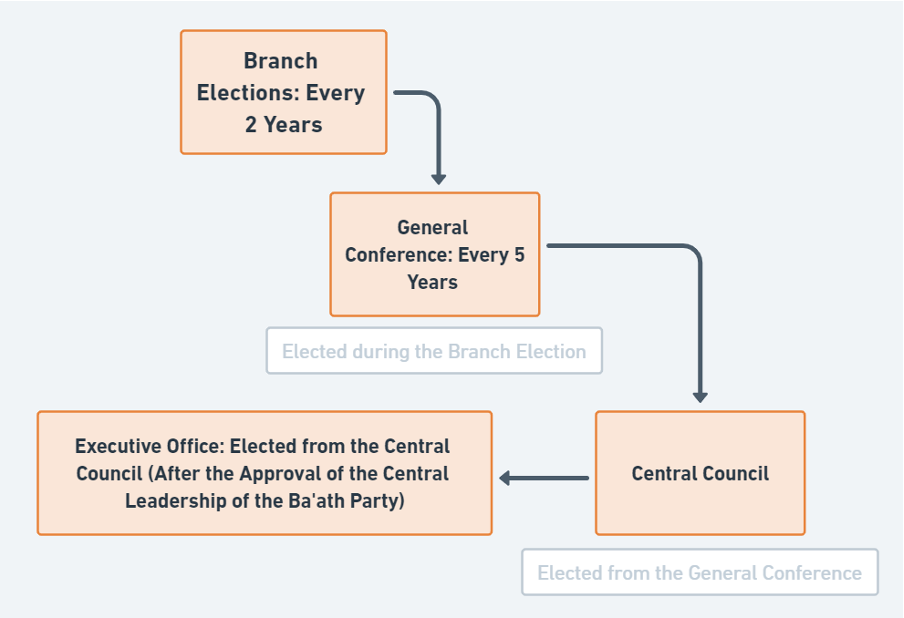
Figure (3): Elections in the National Union of Syrian Students
The Assad regime does not effectively possess any institutes on the ground for qualifying or training young leaders with the aim of exporting them to the upper echelons of the state in the future. Therefore, student organizations at all levels, (starting from the “Ba'ath Vanguards” passing through the “Union of Revolutionary Youth” and ending with the National Union of Syrian Students) represent preparation centers for the Ba'ath cadres, who move after finishing their studies either to lead syndicates or to other positions in the state.
Through these successive institutions, students are groomed on one hand and their loyalty to the ruling authority is ensured on the other, and thus, the idea of elections in the union is more to affirm the chain of loyalty than to be a democratic process among students to choose their representatives entrusted with advocating students' rights in the educational and ministerial councils.
Despite the rigid ring that the regime formed after framing civil society within the policy of the single party; the Syrian revolution and its interactions managed to break this ring in several places, through the defection of individuals who went through the stages of loyalty testing established by the father Assad and sided with the ranks of the revolutionaries.
Universities vary in terms of the composition of branches of the National Union of Syrian Students in them, as branches are primarily divided into 3 types:
1. Branches like Tishreen and Al-Ba'ath display a clear sectarian influence in the Union's makeup.
2. In branches like Aleppo and Damascus, the composition reflects the cities and the balance of power.
3. In branches such as Deir Ezzor and Daraa, the Union's leadership holds minimal influence, and members often hail from the same city.
This variation was clearly reflected in the roles of the Union in the post-2011 phase, in terms of its interaction with the early events, then later its direct role as the central Union leadership or its branches in the governorate, within the context and behavior of the Assad regime in suppressing the revolution, through its official institutions and the auxiliary forces of its army that were established later.
Functional Roles in Service of the Regime
The Ba'ath party was not unaware of the role of civil unrest against military attempts to impose their dominance on the civilian state of the country. Since it took power, civil society has been transformed into a dormant state, starting with the prohibition of societal activities, whether they are service, rights, or sports-related, then framing its institutions within the party's framework, one by one. It managed to make all civil work one of its tools to control society, first, and convey its ideas to successive generations domestically and to foreign countries second.
The Union's roles were not different from the roles of other unions and federations in Syria, as they aligned with Assad's narrative of total societal control. Starting with interacting with the regime's foreign stances regarding regional changes, ending with endorsing its internal decisions on the university and state levels, The National Union of Syrian Students, along with other student-related institutions, was responsible for rallying students in marches that reflect the regime's stance on events such as the invasion of Iraq, the July war in Lebanon, and even its support for Hezbollah under the guise of resistance. This is part of the general picture that the senior Assad had consistently painted; a state that issues decisions and positions that are endorsed by a society that always moves in its favor. The junior Assad continued in this approach, albeit less professionally, due to the change in tools used by those trying to reactivate student civil unrest or otherwise.
After the Syrian regime issued the university regulation law in 2006, one of the law's details was that “the government does not guarantee employment for engineering graduates as was the case before 2006”. This led some students to create sit-ins to protest the decisions, which later expanded to include political demands under the name “Shams Gathering”. This constituted the first semi-organized student movement since Bashar al-Assad took power ([24]). However, the tightly controlled university environment by the triad of teaching and administrative staff and the student union hindered the continuity of this movement, ending it, arresting most participating students and youth. During this period, the roles of the student union were limited to monitoring any movements inside the universities or its associated student housing, with the aim to thwart any movement before it begins. Externally, members of the Union's foreign branches were tasked with following up on the students' news in the resident country, tracking the news of the Syrian community there, maintaining positive relationships with the local student movements in these countries, and establishing ongoing partnerships and events with them.
Since March 2011, universities have significantly interacted with the developments of the popular movement outside their walls. This resulted in an application of the functional and legal structure established after the Ba'ath coup, represented by the local confrontation within the same society's layers or sectors. The direct clash began between students sympathizing with the invaded cities, and the National Union of Syrian Students aiming to neutralize tertiary educational institutions from the popular movement spreading in the country. ([25])
The Union's role began to crystallize on several levels: military, political, and social, within the regime's plan to limit demonstrations away from the governmental, educational, or service buildings. This was later added to the union's narrative by writing: “The Union played a pivotal role in resisting attempts to use university facilities as a means to legitimize the acts of rioting and terrorism that escalated in some Syrian cities” into the introduction of the Union's internal system, which was amended in 2021. ([26])
Repressive Roles and Military Tasks: The Union of Aleppo Students as a Model
The disparity in the reactions of the branches of the National Union of Syrian Students towards the popular movement in the universities was clear, and the military role emerged as one of the roles consistent with the military and security solution of the Ba'ath regime. This was particularly prominent in the University of Aleppo, as most of the Union was composed of the children of Idlib and the countryside of Aleppo, making it difficult for them to confront the movement violently right away. This forced the security branches in the city to gradually escalate violence, by arming the Union students with melee weapons (Sticks - Crowbars - Batons) and giving them the authority to withdraw the ID of students participating in the university demonstrations for later security pursuit. The Union's decision to refrain from excessive violence was in line with the will of the party's branch in the university, as the branch secretary, Abdul Aziz Al-Hassan, refused the security solution and violence in the university, and did not allow the security branches to raid the university extensively, leading to a change in the leadership of the party branch, and Abdul Qadir Al-Hariri taking over, who adopted the security will in excessive violence against any student movement opposing the authority at the University of Aleppo, ([27]) in addition to his decision to dismiss students who participated in the university demonstrations. ([28])
The Union's branch at the University of Aleppo could not stop the student movement at the university, which prompted the regime to search for more organized, effective, and sustainable tools. This led to the formation of the Ba'ath Brigades in 2012 from university students, with their roles lying in two axes:
● Security axis to control the universities with all forms of violence ([29]), and a
● Military axis by participating as auxiliary forces alongside the army in siege operations or battles.
However, later, the Ba'ath Brigades were no longer limited to university students but included party members of different ages. With the escalating role of the Union within the Ba'ath Brigades, sanctions were imposed on Amar Sa'ati, ([30]) who was responsible for the Ba'ath Brigades by the US, ([31]) as part of punishing the leaders of military factions participating in battles and committing massacres. ([32])
As for the less organized military roles, arming the students of the National Union of Syrian Students was present in other branches like the University of Damascus, Al-Baath University, and Tishreen University, but on an individual level and not collectively. The students who were armed were chosen based on loyalties that depend on geographical or sectarian affiliation, or cumulative trust that depends on the extent of services provided to the security branches. This arming aimed to end any movement in the universities by exaggerating the reaction towards participating students to deter their peers from repeating the movement, ([33]) in addition to that, several branches of the Union used places in university housing units, like the University of Aleppo, for arresting and torturing demonstrating students captured by them, before being transferred to the security branches like Damascus and Tishreen universities, where several students were killed under torture after their arrest by the Union members in their universities and their delivery to the security branches.([34])
On a smaller scale of military action, the Union was responsible for inspecting students at the entrances to universities and university housing, and it was the one issuing updates and entrance conditions to universities, coinciding with developments in the surrounding scene at the university. ([35])
This direct arming aimed to stop any movement in Syrian universities without waiting for security or military intervention to control the universities, and the Union members were given all the powers to achieve that, ([36]) along with pursuing activists in the universities with the aim of arresting them. The matter even extended to pursuing professors within universities and arresting them if they have any roles or activities opposing the regime, as happened with Mohammed al-Ahmad, a professor in the French Language Department at Tishreen University.([37])
The Union's military work continued in an organized manner within the Ba'ath Brigades until the present time; centers for the brigades were established in some universities like Aleppo, in addition to centers in all cities, and its social activities are mostly shared with the National Union of Syrian Students, as part of the regime's government plan to export figures from the Ba'ath Brigades as societal and youth faces in the next phase.([38])
Political Marketing of the Regime's Narrative
The National Union of Syrian Students has long served as the primary training hub, grooming individuals for key roles within the Assad regime post their university graduation. This includes positions such as ministers, ambassadors, city party branch leaders, and members of the People's Council. The Union's tradition of molding its members (especially those in the executive office or as Union heads) to become prominent figures in politics and society wasn't a recent strategy introduced by Bashar al-Assad. Instead, it's been a foundational goal since the Union's inception, underscoring its political influence over the past four decades. Notably, Union executive members from the eighties and nineties, like Haitham Al-Duaihi, Wafaa Sunain, Faisal Al-Mikdad, and Hamid Hassan, have maintained significant roles within the state, even post the revolution's onset.([39])
The National Union of Syrian Students was one of the first arms of the Assad regime to interact with the internal developments in Syria, through its internal and external activities. As the regime launched its series of “national dialogues,” the Union was one of the organizations arranging the National Dialogue Conference in July 2011, which was directly funded by the Syria Trust for Development, owned by Asma al-Assad. ([40])
This was followed by a series of dialogues in Syrian universities, aimed at portraying the popular movement as part of a conspiracy against Syria, and that those who participate in it will be part of the war on Syria, and that the only place for change is to participate in these dialogues spread across cities under the supervision and management of the Union.([41]) The Union's interaction with changes continued,([42]) whether at the level of events, or even reactions to demands for constitutional and governmental reform in Syria, in line with the security and military narrative of the Assad regime that it is facing terrorist groups whose goal is to undermine the stability and unity of the country.([43])
The dialogue sessions supervised by the Union continued until the date of preparing this study, within three main axes:
1. Service discussions in Syria as a whole, in terms of organizing universities and even the “formal” activities or campaigns in state institutions, such as combating corruption, in addition to interacting with local administration elections. ([44])
2. The regime's narrative and producing tools to market it internally and externally. ([45])
3. Regarding international changes, whether at the level of the behavior of states towards the Syrian regime, from sanctions or positions, or even ongoing events such as the Russian invasion of Ukraine. ([46])
The Union is now attempting to circumvent the sanctions imposed on the regime. Most western sanctions have been imposed on the regime's ministers, security and military leaders, or individuals involved in economic networks related to it, or even on former members of the Union, like Ammar Saati, who was later promoted. However, sanctions have not been imposed on other Union members despite their involvement in crimes against students, such as Omar Aroub.([47])
Despite the sanctions imposed on it, the Union continues to participate in international conferences, like the Education Summit,([48]) and the International Student Exchange Conference,([49]) Despite the sanctions imposed on the Assad regime.
Social Roles Consistent with the Dynamics of the Regime
The role of the National Union of Syrian Students in supporting the Assad regime post-revolution was not limited to universities and their affiliated institutions. Instead, it also took on roles outside the university that included a social dimension.
After 2011, the regime was keen to establish several of its institutions and associations, either involved in aiding its wounded, promoting it within the community, or even providing the institutions established by regime figures with human resources. An example of this is the agreement signed by the National Union of Syrian Students with the “Wathiqat Watan” project owned by Bouthaina Shaaban, the media advisor to Bashar al-Assad. This project is concerned with documenting events in Syria based on the regime's perspective.([50])
The Union entered into an agreement with a project aimed at involving students in the oral documentation of Syrian events. Additionally, they initiated student competitions to reinforce the regime's narrative both within the student community and the broader society.
Furthermore, as the regime faced increasing casualties and injuries from its confrontations, the Union stepped in as a supplementary institution for social support. They collaborated with the 'Jarih al-Watan' project, overseen by the Ministry of Defense. This partnership led to the formation of a joint committee, headed by Mahmoud al-Shawa, the Deputy Minister of Defense.([51])
The Union turned to establishing subsidiary teams that are not organizationally subordinate to the Union, but the heads of these teams are members of the Union. The role of these teams was relief and social, as part of the regime's attempt to form relief nuclei capable of raising funds, or even reaching all segments of society, and monopolizing student work, even at the level of specializations through initiatives related to university branches, such as the voluntary medical staff headed by the president of the Union at the University of Aleppo.([52])
Summary Conclusions
To grasp the intricacies of Assad's regime, it's vital to see how it seamlessly merges its robust military and security measures with subtler strategies, all designed to dominate the nation and its people. Within this context, the regime has strategically channeled student activities, adapting relevant laws in response to both domestic and international shifts. Notably, since 2011, there have been no significant disruptions or splits at the union's upper echelons. Once Union members transition out, the regime integrates them into various state roles, assigning them to internal political, administrative, or foreign diplomatic duties.
The legal frameworks governing student activities mirror the regime's intent, framing public space and harnessing it as a series of tools to sustain and establish its rule. Post-revolution, the regime seeks to placate its allied factions by legally granting them scholarships, regardless of their military service status or Syrian nationality. Concurrently, the union's influence has expanded since the Ba'ath takeover, now spanning military, religious, and societal domains, beyond its primary role.
The Union also possesses a clear administrative structure within its internal, ostensibly non-party system. Still, administratively, the Union follows the central youth office in the Ba'ath Party. Branch presidents and office members are chosen based on university significance, with selections influenced by regional, tribal, and ethnic factors. Yet, genuine democratic elections and position rotations have been conspicuously absent for over half a century since the Union's inception.
On an international level, the union is not merely a tool to control universities, their students, and related facilities. Instead, it plays a critical part in rehabilitating and cleaning up the image of the regime through students who study at universities and participate in international conferences and events, both political and social. These students also spy on their peers in those countries and promote the regime's narrative about ongoing events in the country.
In conclusion, Assad regime institutions align in their importance for controlling society and preventing any attempts for change. An essential part of dismantling these institutions is understanding them, their dynamics, tools, the spaces of their roles, and their impact. The National Union of Syrian Students is among the most crucial, and dismantling these institutions' structure is an initial step in reducing their effectiveness externally and detaching student work in Syria from the Ba'ath regime. This move is part of a vision to achieve a peaceful transition for all state institutions and civil society and apply transitional justice.
Appendix 1
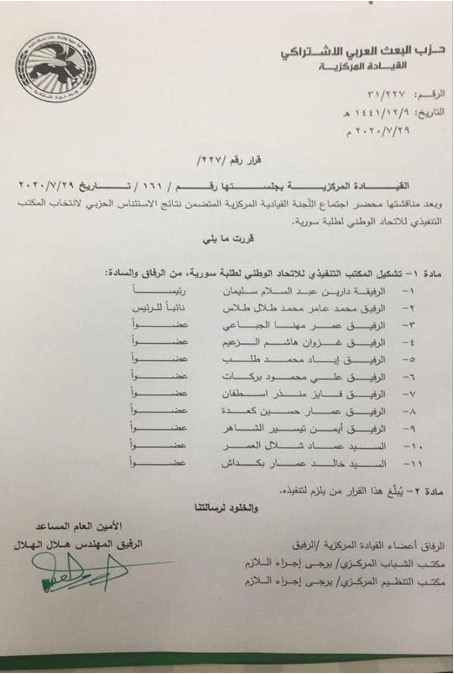
Appendix 2
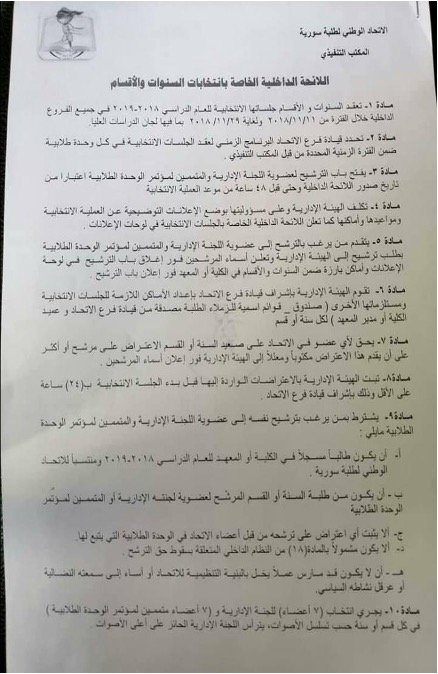
([1]) El Amine, A. (2019). Governance of Higher Education in the Arab World and the Case of Tunisia. International Higher Education, (97), 7-9. https://bit.ly/3JUJfSs
([2]) Aljasem, A. (2021). In the shadow of the state: The rise of Kata’ib al-Baath at Aleppo University after 2011. Journal of Perpetrator Research, 3(2), 87-113. https://bit.ly/3FOBg7Q
([3]) Watenpaugh, K. D., Fricke, A. L., & King, J. R. (2014). We will stop here and go no further. Syrian University Students and Scholars in Turkey. Institute of International Education. https://bit.ly/3veuOlN
([4]) The term 'Sheikh al-Kar' refers to an ancient position during the Ottoman Empire era. In every craft or trade, there was a 'Sheikh al-Kar' who ruled in disputes and was responsible for the workers in that specific profession.
([5]) Lebanese University, Legal Informatics Center, Law of Associations, issued on August 3, 1909 https://bit.ly/3Mb1rdw
([6]) It was established in 1921 by several national figures, the most prominent of which is Fares Khoury", the history of the Bar Association in Syria, Syria News website, January 2015 https://bit.ly/3PQHybM
([7]) "Its role became clearly prominent after the establishment of the cement factory in Damascus in 1928" - Abdullah Hanna, The Labor Movement in Syria and Lebanon 1900-1945, Dar Damascus, 1973.
([8]) Article 17: Syrians have the right to form associations and to join them, provided that their aim is not prohibited by law, Syrian Constitution of 1950 https://bit.ly/3Q8asEx
([9]) The Syrian Arab Republic, Ministry of Social Affairs and Labor, Law of Associations and Private Institutions No. /93/ of the year 1958 https://bit.ly/3HYENmM
([10])Contemporary Syrian History, Decree Establishing the National Union of Syrian Students, Legislative Decree No. 130 of 1966 https://bit.ly/3vdTQ4u
([11])Contemporary Syrian History, Decree Establishing the Revolution Youth Union, Legislative Decree No. 23 of 1970 https://bit.ly/3FOAqYA
([13]) Syrian Parliament's official website, University Regulation Law NO. 6 of 2006 https://bit.ly/3VvqYzg
([14]) Syrian Parliament's official website, University Regulation Law NO. 1 of 1975 https://bit.ly/3jvuyMB
([15]) Syrian Ministry of Education website, Decision NO. 252 of 2015, related to the formation of the Higher Education Budget Committee https://bit.ly/3PSoXvY
([16]) This refers to studying in public universities through the competitions conducted by the Ministry of Higher Education.
([17]) Clause B - Article 196 of the Executive Regulations for the University Organization Law of 2006:
The self-resources mentioned in paragraph (A) are placed in a separate account in the Commercial Bank of Syria according to their receipt in Syrian pounds or foreign currencies. The disbursement from this account should be according to the following priority order:
1- A- The goals related to the plans and programs for modernizing and developing higher education and promoting universities, which are determined by the Minister through a decision coordinated with the Minister of Finance. These goals should not be less than 60% of the total self-resources, and the disbursement is done by the University president through official bonds.
B- Allocating a percentage that does not exceed 40% of the investment allowances in restaurants, forums, canteens, and kiosks. The percentage is calculated annually by a decision from the Minister in agreement with the Minister of Finance, which determines the disbursement aspects and the benefiting entities.
([18])Higher Education Council website, Decision NO. 274 of 2011 https://bit.ly/3GgluD9
([19]) Syrian Parliament's official website, Legislative Decree NO. 36 of 2001 https://bit.ly/3VG5QGR
([20]) Article 116- It is not permissible to accept any student on a personal basis without adhering to the order of success scores and other standards set by the Higher Education Council, except as follows:
1- The children of the holders of the Hero Medal of the Syrian Arab Republic are accepted in the branch they wish to join according to the type of secondary school certificate.
2- A: A number not exceeding five students in each college or department or specialization from the children or siblings or spouses of those who were martyred in the war or were martyred in the Palestinian armed struggle or were martyred due to their official duties. The Higher Education Council determines the cases of martyrdom due to official duties, and acceptance is through competition among them by a decision of the minister according to the order of success in the secondary certificate and according to the standards set by the Higher Education Council.
([21]) Syrian Parliament's official website, Legislative Decree NO. 100 of 2011 https://bit.ly/3PW2Rsq
([22]) The Central Youth Office in the Party is responsible for the Vanguard of the Baath, the National Union of Syrian Students, the Union of Revolutionary Youth, the General Sports Federation, and the Baath Brigades.
([23]) Refer to:Bashar Mutlaq: Chosen to head the special organizing committee for participants," in the affirmation of the committee to discuss the current constitution and its tasks in the Syrian National Dialogue Conference in Sochi, SANA news agency https://bit.ly/3Gls7oH. Current member of the People's Council, National Media Agency, Names of the new Syrian People's Council members 2020 https://bit.ly/3vhJiRE
Mohammed Ojail: Current member of the People's Council, previous reference.
Omar Al-Aroub: Former member of the People's Council for the legislative term 2016-2020 https://bit.ly/3jvKU82 , head of the regime's Olympic mission to the Tokyo 2020 Olympics, current Vice President of the General Sports Federation, and Deputy Commander of the "Ba'ath Brigades".
([24]) Experiences from the Political Activity of Youth Before and During the Revolution", Syria Freedom website, 16/02/2016 https://bit.ly/3WFswZU
([25]) Storming the International University of Science and Technology https://www.youtube.com/watch?v=rXzr2HtsU40
([27]) From an interview conducted with researcher Ali Al-Jasem, a former member of the Aleppo branch of the National Union of Syrian Students.
([28]) Aleppo University dismisses students who participated in protests against the regime, Zaman Al Wasl, 15/01/2013 https://shorturl.at/awEH8
([29]) Unit number 20 in the university city of Aleppo was converted into a temporary detention center supervised by the Ba'ath Brigades – from the previous interview with Ali Al-Jasem.
([30]) Ammar Sa'ati became responsible for all student institutions within his position as head of the Central Youth Office in the Central Committee of the Ba'ath Party, in addition to the Ba'ath Brigades.
([31]) U.S. DEPARTMENT OF THE TREASURY, Treasury Sanctions Senior Syrian Government Officials,Augustus 2020 https://bit.ly/3nqHAK9
([32]) The current commander of the Ba'ath Brigades is Bassem Sudan, who was the vice president of the National Union of Syrian Students until 2020.
([33]) Storming the International University of Science and Technology, November 2011 https://bit.ly/3QaZRZv
([34]) Ayham Ghazoul's death under torture after his arrest by Union members at Damascus University - An investigation by Human Rights Watch, 'If the Dead Could Speak', December 2015 https://bit.ly/3B0v1fx
([35]) The National Union of Syrian Students tightens security measures at Tishreen University https://bit.ly/3XIMYsM
([36]) Security forces, along with members of the Damascus branch of the Union, stormed the Private Arab University following protests there, and students were assaulted in collaboration with Union branch members at the university https://bit.ly/3gLjREs
([37]) He was arrested, and the National Union issued a statement regarding him, confirming his suspension from teaching and his arrest, December 2018 https://bit.ly/3iviQBf
([38])The regime promotes “Al-Ba'ath Brigades” as a front for Syrian youth. What is the relationship with the Chinese Communist Party?, Syria TV, 13/10/2022 https://bit.ly/3gMZ3wD
([39]) Haitham Al-Duaihi: Former president of the National Union of Syrian Students from 1976 until 2000, Minister of Presidential Affairs 2000-2003, former member of the People's Council, Deputy Chairman of the Central Committee for People's Reconciliation 2014.
Wafaa Sunain: Former member of the Union's Executive Office, Director of Planning and Training in the Ministry of Education, Deputy Minister of Education 2014.
Faisal Al-Mikdad: President of the Union branch at Damascus University - Member of the Executive Office of the Student Union 1981 - current Minister of Foreign Affairs.
Hamid Hassan: Syrian Ambassador to Tehran 2006 - Deputy Minister of Foreign Affairs and Expatriates - current member of the People's Council.
([41]) Dialogue sessions in Raqqa city, July 2011. https://bit.ly/3UvJNC9
([42]) A pro-government march in Aleppo organized by the National Union of Syrian Students and the Union of Revolutionary Youth, June 2011. https://bit.ly/3EKAo3K
([43])The pages of the Syrian Student Union launched a widespread campaign against those calling for the abolition of Article Eight of the Constitution, which states that the Ba'ath Party is the leading party of the state and society, July 2011 https://bit.ly/3AVskfb + https://bit.ly/3GWu77O
([44]) The Union launched a series of dialogues as part of the "First Neighbor" initiative, August 2022. https://bit.ly/3t0EpLO
([45]) A meeting for active students in dialogue sessions with Bashar al-Assad. https://bit.ly/3GVSTF0
([46]) A dialogue session held by the National Union titled (The conflict in Ukraine and its international and Syrian implications), April 2022. https://bit.ly/3tXPrSB
([48]) The National Union of Syrian Students' page on Facebook https://bit.ly/3g40Ahr
([49]) The National Union of Syrian Students' page on Facebook https://bit.ly/3Vwv2Ql
([50]) 'Wathiqat Watan' Website, Who We Are? https://bit.ly/3jwK6zB
([51]) Signing of a cooperation agreement between 'Jarih al-Watan' Project and the National Union of Syrian Students, August 2022. https://bit.ly/3Xjg2XQ
([52]) The National Union of Syrian Students - Union branch at Aleppo University's Facebook page. https://shorturl.at/DLX78


